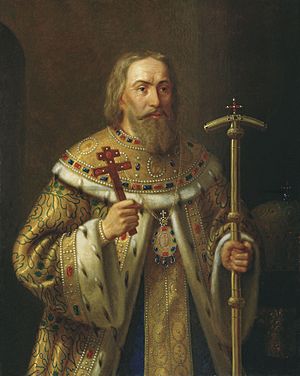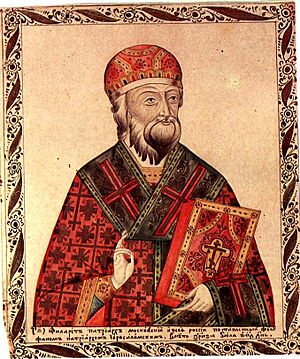Patriarch Filaret of Moscow facts for kids
Quick facts for kids Filaret |
|
|---|---|
| Patriarch of Moscow and all Russia | |
 |
|
| Church | Russian Orthodox Church |
| See | Moscow |
| Enthroned | 1619 |
| Reign ended | 1633 |
| Predecessor | Hermogenes |
| Successor | Joasaphus I |
| Personal details | |
| Birth name | Fyodor Nikitich Romanov |
| Born | c. 1553 Moscow, Russia |
| Died | 1 October 1633 (aged 79–80) Moscow, Russia |
| Buried | Dormition Cathedral, Moscow |
| Denomination | Orthodox Christianity |
| Parents | Nikita Romanovich Princess Evdokiya Alexandrovna Gorbataya-Shuyskaya |
| Spouse | Xenia Shestova |
| Children | Mikhail Fyodorovich Romanov 5 others |
Feodor Nikitich Romanov (Russian: Фео́дор Ники́тич Рома́нов 1553 – 1 October 1633) was a Russian noble, known as a boyar. After facing some difficulties, he became the patriarch of Moscow with the name Filaret (Russian: Филаре́т). He was like the real ruler of Russia when his son, Mikhail Feodorovich, was the tsar.
Contents
Biography
Feodor was born in Moscow around 1553. He was the second son of a well-known boyar named Nikita Romanovich. Feodor was the first person in his family to use the last name Romanov.
When his cousin Feodor I was tsar (1584–1598), young Feodor Romanov was a good soldier and diplomat. He fought against the forces of John III of Sweden in 1590. He also talked with ambassadors from Rudolf II, Holy Roman Emperor between 1593 and 1594. He became a Boyar in 1583.
When Tsar Feodor I died without children, many people wanted Feodor Romanov to become the next tsar. But he agreed when Boris Godunov was chosen instead. Three years later, Boris Godunov forced Feodor and his wife, Xenia Shestova, to become monks and nuns. Feodor became Filaret, and Xenia became Martha.
Filaret was held in a very strict prison at the Antoniev Siysky Monastery. He was treated very badly there. But when False Dmitriy I took power from the Godunovs, he set Filaret free. He then made Filaret the metropolitan (a high-ranking bishop) of Rostov in 1605.
Patriarch of Moscow
In 1609, Filaret was captured by False Dmitriy II, another person pretending to be the tsar. This False Dmitriy named Filaret the Patriarch of all Russia. However, Filaret's power only reached the small area that supported this impostor.
From 1610 to 1618, Filaret was a prisoner of the Polish king, Sigismund III Vasa. He refused to accept Sigismund as the tsar of Muscovy when he was sent to the Polish camp in 1610.
Filaret was finally set free when the truce of Deulino was signed on February 13, 1619. On June 24 of the same year, he officially became the Patriarch of Moscow and all of Russia.
From that time until his death, Russia was ruled by two leaders. Tsar Michael and his father, Patriarch Filaret, were both in charge. They were like co-regents, meaning they ruled together. Filaret often made important decisions for the country without asking the tsar.
He helped fill the country's treasury (money storage) by creating a fairer way to collect taxes. One of his most important actions was to make sure that peasants stayed on their land. This stopped them from moving to the steppes, where they became freebooters (like bandits) instead of taxpayers. He also started taxing the tsar's military tenants, which was a step towards taxing all classes fairly.
Filaret was very dedicated to the Orthodox faith. He encouraged the printing of religious books and started a large library for the Patriarch. He also ordered every archbishop to create a seminary (a school for clergy) and led by example.
Another big help Filaret gave his country was making the Muscovite army stronger. He did this with the help of officers from other countries. When he died in October 1633, it ended the Russo-Polish War (1632–33). His death took away a strong support for Tsar Michael, who was not as strong a ruler on his own.
In May 1625, Filaret issued a special order. This order gave the patriarch the right to judge and oversee church members and peasants in most matters. This meant that under Filaret, the patriarchate became like a "state within a state." It had its own structured administration, which also became more complex.
The patriarchate's administration had different parts:
- The Judicial department handled legal matters.
- The Ecclesiastical department looked after church parishes.
- The Treasury department collected taxes from the clergy.
- The Palace department managed the money matters of the patriarch's own lands.
Each department was led by a patriarchal boyar, a high-ranking noble. Clerks and scribes worked in these departments. Filaret himself would read and sign reports. He also ordered a full check of all church and monastery property. He also reviewed all the land given to monasteries.
In 1620, a new church area called the Diocese of Tobolsk was created.
In 1625, the king of Persia gave Filaret a special gift: a piece of what was believed to be the Seamless Robe of Jesus. This holy item was placed in a shrine in the Kremlin's Assumption Cathedral. Today, it is kept in the Cathedral of Christ the Savior in Moscow.
Legacy
Filaret was very important in starting the Romanov family as the ruling family of Russia. He used grand ceremonies and building projects to show how important the Crown was.
Because of the Thirty Years' War, many soldiers for hire (mercenaries) were available. So, Filaret hired English and Scottish officers to make the Russian army more modern. This helped Russia move forward into a new age.
Issue
Filaret and his wife Xenia Shestova had six children. Only two of them lived to be adults:
- Tatyana (died 1612), who married Prince Ivan Mikhailovich Katyrev-Rostovsky. They had no children.
- Boris (born 1592, died as a baby)
- Nikita (born 1593, died as a baby)
- Michael (1596-1645), who became the first tsar of Russia from the House of Romanov.
- Lev (born 1597, died as a baby)
- Ivan (born 1599, died as a baby)
See also
 In Spanish: Filareto I de Moscú para niños
In Spanish: Filareto I de Moscú para niños


